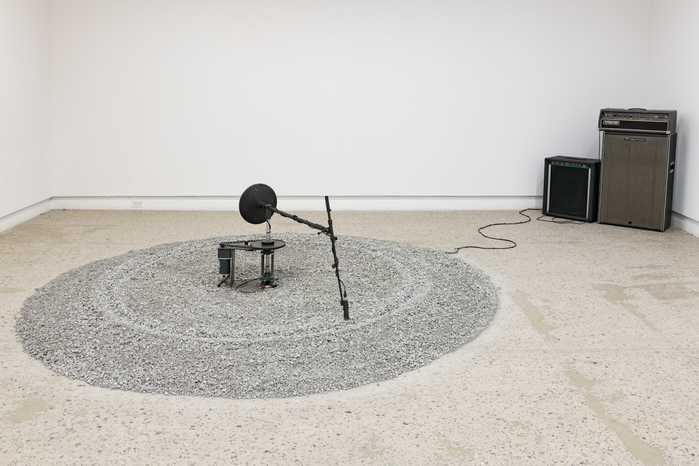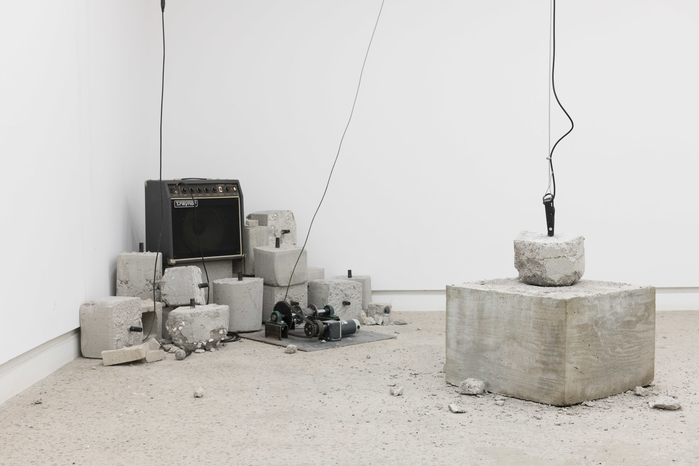Italian artist Roberto Pugliese employs the same principles of feedback, particularly in his 2011 piece Equilibrium. Composed of metal, acrylic, microphones, motors, and electronic circuits, Equilibrium harnesses the phenomenon of feedback to engender a sense of unease within its listener. The work’s plastic supports are mounted to the gallery wall in an L shape. A microphone is affixed to a moving robotic arm which is attached to the bracket that also holds an audio cone. The installation’s kinetics allow the microphone to modify and vary its distance from the speaker. Within each pairing, the size, power, and resonance of the speaker cone varies, nuancing the sound that each assemblage emits. As Pugliese describes, “When a microphone is located in the vicinity of a cone it induces the system to go into feedback mode bringing it to the saturation of the signal, and subsequently to [a] breaking point” (Pugliese 2011). He goes on to explain, “In this way, each micro system seeks – without finding it – its own equilibrium, which is physically impossible to obtain. The Larsen effect, usually perceived as an annoying error, becomes the driving force behind the work.” Pugliese, who was trained in Italy as a composer, deploys feedback specifically as his sonic material, creating a soundscape that is at once pleasantly dynamic and mercurial. The equilibrium the assemblage seeks is also sought by its listener. The mechanization of the work further reduces the control of the listener, which adds to its insidiousness.
For Pugliese and Basanta multiple meanings are enfolded within the basic instruments used for public address (the microphone and the speaker). Combined with noise sounds, these components symbolize a combined potential as tools of both resistance and suppression. Basanta pointedly describes the microphone as “an indispensable instrument of the modern demagogue” (Basanta 2019) but also proposes feedback as a oppositional strategy that disrupts flows of sonic information. He subverts these tools of mass broadcast by substituting the human voice in favor of atonal ringing. He further considers the technologies of sound production, noise, and power in a more recent work, A Large Inscription, A Great Noise (2019). A two part installation, A Large Inscription is composed of the raw materials of sound and stone. A microphone mounted on a stand that slowly spins is positioned in the center of a circle of gravel; it is extended downwards into the pile of stones and rotates slowly but consistently, emitting a muffled grating sound. The rotating mic is connected to an amplifier that is positioned in the corner of the gallery. The rotation of the mic and its labored soundtrack are Sisyphean in their drudgery and perpetualness. Situated within the typically muted exhibition space, the constant sound is vexing, yet eventually becomes predictable.
The second component of Basanta’s installation is titled A Great Noise and consists of various microphones encased in cement. This work recalls the aesthetic austerity of Bruce Nauman’s Concrete Tape Recorder Piece (1968), in which an active cassette player repeating a scream is encased in cement, as well as Michael Sailstorfer’s Reaktor (2005) series which sees microphones similarly embedded in concrete. For each piece in Sailstorfer’s series, a microphone is connected to a loudspeaker, while the block of concrete acts as a transducer. As people enter the gallery space, the sound sculpture picks up vibrations, the volume increasing with each new visitor. When the space is empty, the piece falls quiet. When the exhibition space is fully occupied, the piece is, in the words of the artist, “confrontational and aggressive” (Simpson 2016: 96).
In Basanta’s piece, one concrete block is rigged with a kinetic pulley system that is attached to the gallery’s ceiling. At the top of this block, the handle of a microphone peeks out and is connected to the pulley system. The block ascends, slowly, dangling in the air. Once it reaches its prescribed altitude, the rock plummets towards the floor, landing on a large concrete podium with a loud crash. Pieces of the block scatter as a result of the impact. After a resonant pause, the block is then hoisted up again, continuing the cycle until there is little left to destroy. It is then replaced by one of the many other entombed microphones that are positioned in the corner of the gallery. In irregular intervals the gallery alternates from a muted space of anticipation to a domain of noisy uneasiness. In the typically muted white cube exhibition space the intermittent sound is a disruption that is inflicted on its listeners, violating the codes of behavior prescribed by the gallery context. As articulated in Basanta’s own description of the work, the installation further registers a critique of mass broadcast through the destruction of its tools. Through this process he suggests a means to break free from an overwhelming and oppressive climate of information media.





